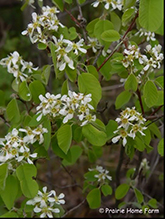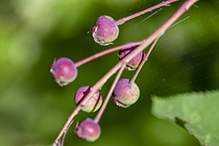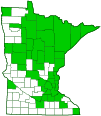downy serviceberry
(Amelanchier arborea)
Conservation • Wetland • Description • Habitat • Ecology • Use • Distribution • Taxonomy
Description |
||
Downy serviceberry is a tall shrub or small tree. In Minnesota it is usually 10′ to 25′ tall. It is sometimes much taller but rarely more than 40′ tall and rarely less than 6½′ tall. It rises on multiple upright stems. When it is single stemmed, the stem is usually up to 3″ in diameter. It does not spread by underground stems (rhizomes). The crown is usually taller than wide. The bark is thin, smooth, and gray when young, developing shallow, vertical furrows and flat ridges with age. First year branchlets are slender, greenish, flexible, and usually hairy. In the second year they are brown to reddish-brown and hairless with a few scattered, light-colored lenticels. Terminal buds are up to ½″ long with a long point. They are light yellowish-green to greenish-red and have a fringe of hairs on the margins. Lateral buds often hook slightly around the twig. The leaves are alternate, egg-shaped to elliptical, 1½″ to 3″ long, and 1″ to 2″ wide. They are on slender, light green, ⅝″ to1¼″ long leaf stalks (petioles). The petioles are hairy, especially in the spring but also at maturity. The leaf blades are rounded or slightly heart-shaped at the base and taper to a point at the tip. The upper surface is dark green, dull, and hairless or almost hairless. The lower surface is pale green and is densely covered with white hairs when young, becoming less hairy but retaining at least hairs along the midrib at maturity. The margins are finely and closely toothed with sharp, forward-pointing teeth. Larger leaves have 25 to 45 teeth per side. The toothed part of the margin extends nearly to the rounded base. The inflorescence is an unbranched, 1½″ to 3″ long cluster (raceme) of 5 to 12 flowers at the end of the stems and branches. The flowers appear from late April to late May when the leaves are just starting to unfold. Each flower is on a hairy flower stalk (pedicel). The lower pedicels are 3 ⁄16″ to 1″ long. The flowers have both male and female reproductive parts. There are 5 sepals, 5 petals, 20 stamens, and 5 styles. The sepals are green, triangular, hairy, bent backwards, and short, ⅛″ to 3 ⁄16″ long. The petals are white, narrowly egg-shaped to narrowly oblong, and 7 ⁄16″ to ⅝″ long. They are at least 2 times longer than wide. The ovary is hairless at the top. The flowers are mildly fragrant. The fruit is a more or less globe-shaped, 5 ⁄16″ to ½″ in diameter, pome with 4 to 10 seeds. They are green at first, becoming red, then purplish-black at maturity. It is somewhat dry and mostly tasteless. |
||
Height |
||
10′ to 25′ |
||
Flower Color |
||
White |
||
Similar Species |
||
Habitat |
||
Dry. Upland woods, open forests, swamp edges. Full to partial sun. |
||
Ecology |
||
Flowering |
||
Late April to late May |
||
Pests and Diseases |
||
|
||
Use |
||
|
||
Distribution |
||||
|
Sources |
|||
| 4/10/2023 | ||||
Nativity |
||||
Native |
||||
Occurrence |
||||
Common in eastern North America west to the St. Croix Valley of Minnesota. |
||||
Taxonomy |
|||
| Kingdom | Plantae (Plants) | ||
| Subkingdom | Pteridobiotina | ||
| Phylum | Tracheophyta (Vascular Plants) | ||
| Class | Magnoliopsida (Dicots) | ||
Order |
Rosales (Roses, Elms, Figs, and Allies) | ||
Family |
Rosaceae (Rose) | ||
| Subfamily | Amygdaloideae | ||
| Tribe | Maleae | ||
| Subtribe | Malinae | ||
Genus |
Amelanchier (serviceberries) | ||
Subordinate Taxa |
|||
|
|||
Synonyms |
|||
Amelanchier arborea var. arborea Amelanchier arborea var. alabamensis Mespilus arborea Amelanchier alabamensis |
|||
Common Names |
|||
Allegheny serviceberry apple shadbush common serviceberry downy Juneberry downy serviceberry downy shadbush juneberry shadblow |
|||
Glossary
Pedicel
On plants: the stalk of a single flower in a cluster of flowers. On insects: the second segment of the antennae. On Hymenoptera and Araneae: the narrow stalk connecting the thorax to the abdomen: the preferred term is petiole.
Petiole
On plants: The stalk of a leaf blade or a compound leaf that attaches it to the stem. On ants and wasps: The constricted first one or two segments of the rear part of the body.
Pome
A fruit with a central seed bearing core enclosed in thick flesh, e.g., an apple or pear.
Raceme
An unbranched, elongated inflorescence with stalked flowers. The flowers mature from the bottom up.
Rhizome
A horizontal, usually underground stem. It serves as a reproductive structure, producing roots below and shoots above at the nodes.
Visitor Photos |
|||||
Share your photo of this plant. |
|||||
| This button not working for you? Simply email us at info@MinnesotaSeasons.com. Attach one or more photos and, if you like, a caption. |
|||||
Bill Reynolds |
|||||
 |
|||||
MinnesotaSeasons.com Photos |
|||||
Leaf |
|||||
 |
|||||
Fruit |
|||||
 |
|||||

Slideshows |
||

Visitor Videos |
|||
Share your video of this plant. |
|||
| This button not working for you? Simply email us at info@MinnesotaSeasons.com. Attach a video, a YouTube link, or a cloud storage link. |
|||
Other Videos |
|||

Visitor Sightings |
|||||
Report a sighting of this plant. |
|||||
| This button not working for you? Simply email us at info@MinnesotaSeasons.com. Be sure to include a location. |
|||||
|
|||||
MinnesotaSeasons.com Sightings |
|||||

Created: 5/27/2014
Last Updated:
